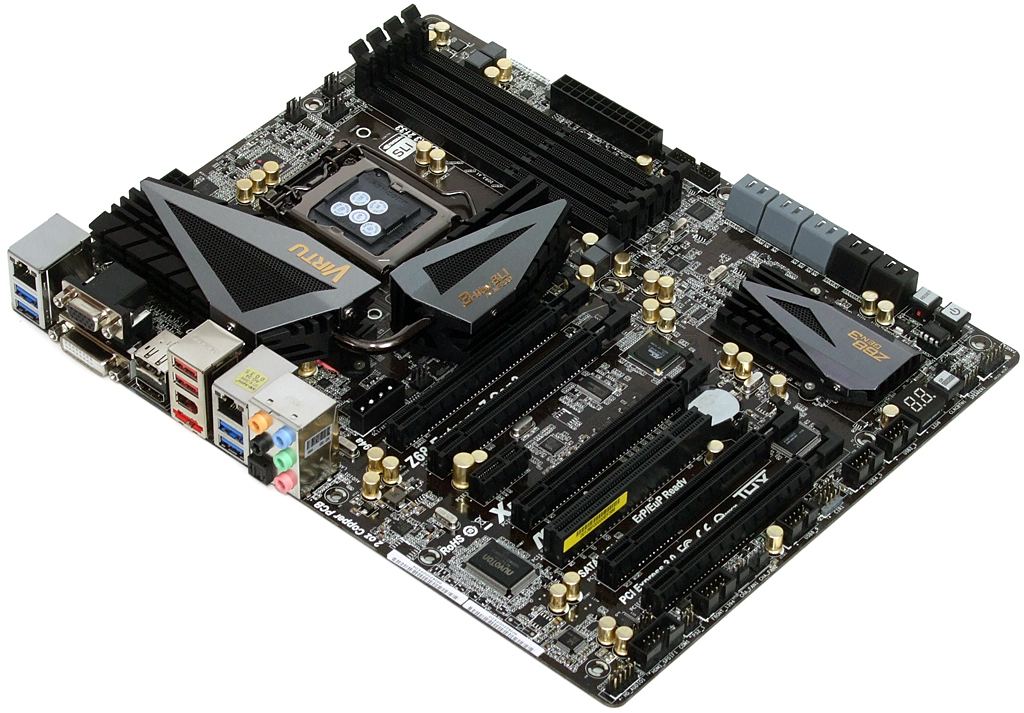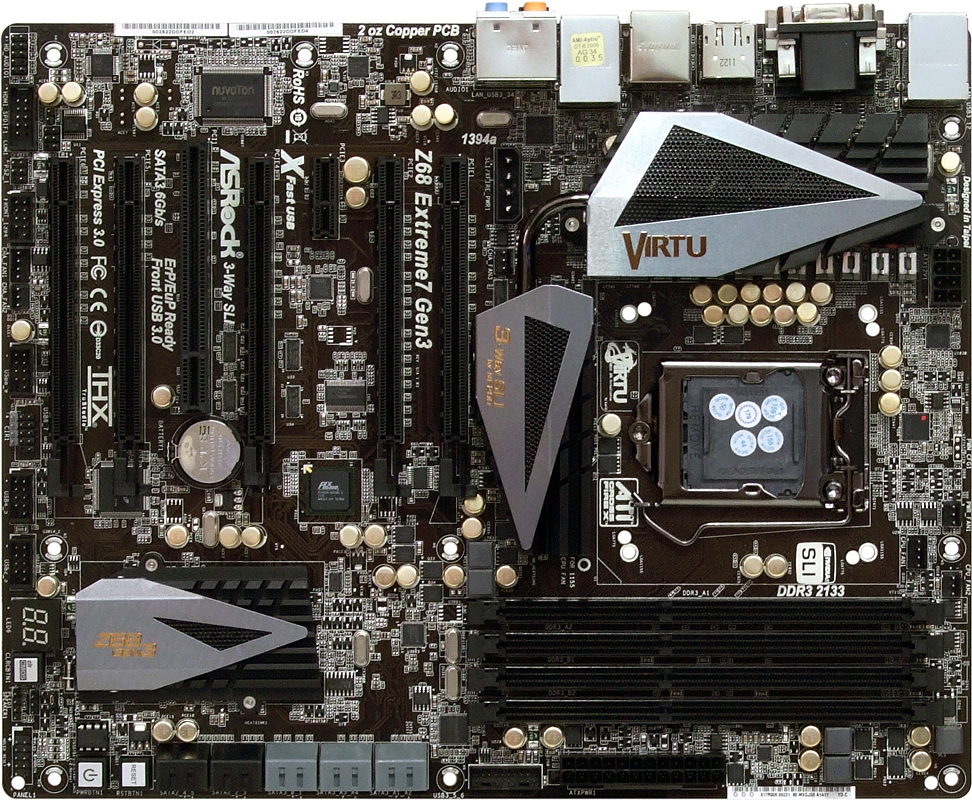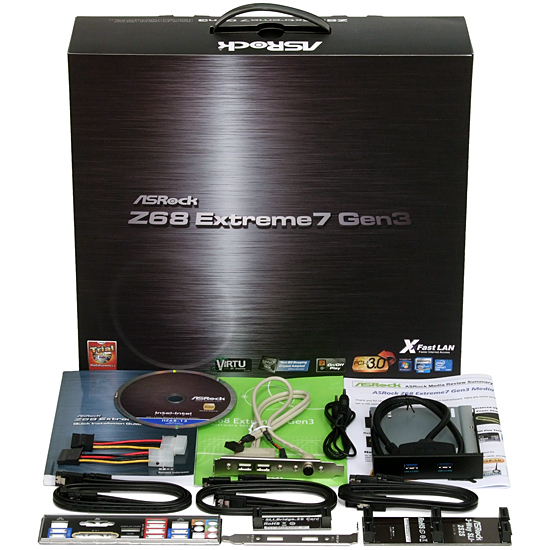Round-Up: Four Z68 Motherboards From $220 To $280
A real enthusiast chipset deserves a real enthusiast motherboard. Today we're comparing four feature-packed platforms that most folks who call themselves hardcore (and informed enough to know what hardware meets their needs) can actually afford.
ASRock Z68 Extreme7 Gen3
Companies are always asking us what it takes to win an award for product leadership, and we pass along our advice whenever we can to help the industry as a whole. Without fail, adding functionality to a lower price tag is almost always a recipe for a strong value-based win. ASRock is one of those companies generally willing to listen to what we'd like to see on a motherboard, and this reflects in boards that we end up singling out for their smart specification lists.
We don’t always get what we want, though, and the I/O panel of this board is proof of that. ASRock insisted on placing a VGA port there, even though we don't know any high-end users still rocking CRTs or cheap LCDs. And though we do know of a few enthusiasts who still swear by older keyboards and mice, ASRock removes the PS/2 port to make room for VGA.
The one recommendation ASRock did implement was our desire to see two PCIe bridges: one for the CPU and one for the platform controller hub to enable three-way SLI with all of the slots populated. Nvidia’s NF200 doubles the CPU’s PCIe lanes by repeating identical data to multiple cards. Of course, that feature only works when cards use identical data, as they would in SLI or CrossFire mode.
The other PCIe bridge is a PEX8608 that allows two BCM57781 network controllers, two AMS1042 USB 3.0 controllers, two PCIe x1 slots, an ASM1061 four-port SATA 6Gb/s controller, a VT6315N FireWire controller, an ASM1083 PCIe-to-PCI bridge, and a PCIe x4 slot to all work simultaneously on a chipset that has only eight PCIe 2.0 lanes. The 20 Gb/s DMI between the CPU and chipset limits full bandwidth to the equivalent of four devices. But we don't know of many users who would employ all of those interfaces at full bandwidth simultaneously. ASRock's other option would have been to disable some features whenever others are enabled. But we'd rather have access to all of a platform's features when they're needed rather than be forced to pull a card to enable a port, for example.
One spec from the preceding feature table that might confuse readers our claim of four x16-length slots when five can clearly be seen on the board. In order to get PCI Express 3.0 support on a board that uses Nvidia’s PCIe 2.0-capable bridge, the company connects the second x16 slot directly to the CPU. Meanwhile, the first, third, and fourth PCIe slots are connected to NF200. PCIe 3.0 pathway switches choose between activating the second x16 slot or the NF200 controller based on which slots are populated. In other words, PCIe 3.0 is limited to the second 16-lane slot, while SLI and CrossFire are accessible from the other slots. And, when x16 slots 1, 3, or 4 are needed, slot 2 can't be used. Fortunately, the slot that gets disabled in CrossFire and SLI configurations is the one that's typically blocked-off by the GPU cooler of the top graphics card.
Card spacing is set almost perfectly for three-way SLI, with three spaces between the first and third PCIe x16 slots. The reason we mention SLI specifically is that some of Nvidia’s cards have a hole in the back that allows air into the fan from either side. The extra space consequently serves both the top and middle cards. Cooling isn’t a major concern for the third card, since its fan faces away from the other cards.
None of that discussion even considers the four-lane PCIe 2.0 slot at the bottom of the board, since it isn’t intended for SLI or CrossFire applications.
Get Tom's Hardware's best news and in-depth reviews, straight to your inbox.
One of the SATA 6Gb/s ports added by the ASM1061 four-port controller is also shared with eSATA. That means users must pick between a maximum of ten internal drives, or nine internal and one external drive. Fortunately, that's not a choice most of us ever have to make.
Does anyone remember building Baby AT systems with a PS/2 mouse port? ASRock brings back the long-forgotten 2-port USB plus single-port PS/2 breakout plate specifically to serve those of us who won’t give up their old keyboards or mice. The presence of six SATA cables pleases us, along with the solid three-way SLI bridge and USB 3.0 drive bay adapter.
Current page: ASRock Z68 Extreme7 Gen3
Prev Page Four Z68 Express-Based Motherboards For Enthusiasts Next Page Z68 Extreme7 Firmware-
RazorBurn Only Asus and AsRock for me.. Tried severals boards thru the years yet only this two has never failed me..Reply
My AsRock AliveNF6G-VSTA in my warehouse full of dust, mites, cobweb still works.. Recently upgraded to 4GB RAM and GTS 450 1GB video card.. -
iam2thecrowe i would like to see a more budget oriented roundup, not everyone wants to spend that much on a motherboard for 0.5 of an FPS increase, or overclock 100mhz more out of their cpu.....Reply -
beenthere Intel mobos are way over-priced IMO. In my many years of building PCs the only two mobos that I ever had fail were Asus. As far as performance and reliability I'd rank these mobo brands as follows:Reply
Gigabyte
MSI
Asus
Asrock -
flong I own the AsRock Extreme 4 Gen 3 board and it seems to be a very good board. I had the Asus Pro V before and had problems. I can say from experience that Asus's customer service is VERY poor to say the least. While their boards seem to be high quality according to most reviews, if you do have a problem don't count on Asus being around to help you out. I sent my board back to NewEgg and I had to argue with Newegg to get them to warranty it which was disappointing. Amazon does not have this problem and for my next motherboard purchase I will probably go through Amazon.Reply
The answer to my first email question to Asus came a three full weeks later AFTER I had decided to return the board. AND the answer was an absolutely stupid response that did not address the real problem. Still wanting an answer to my question, I clarified the question and sent it back to Asus again. TWO weeks later I got ANOTHER asinine response from them. At that point I realized I was wasting my time.
I don't know how good AsRock's customer service is since I have not had a problem with the board. -
Crashman iam2thecrowei would like to see a more budget oriented roundup, not everyone wants to spend that much on a motherboard for 0.5 of an FPS increase, or overclock 100mhz more out of their cpu.....I believe you missed this:Reply
http://www.tomshardware.com/reviews/z68xp-ud3-dz68db,2980.html
-
Mark Heath Reply
Crashman to the rescue again :)9519804 said:I believe you missed this:
http://www.tomshardware.com/reviews/z68xp-ud3-dz68db,2980.html -
Novuake Intel boards are not that bad, yes their Enthusiast boards are, but for a good while after LGA1155 came out they had the cheapest USB3/SATA 3 LGA1155 boards available, I think they still do... I would have to check.Reply -
Luay The Asrock Extreme7 belongs in another NF200 equipped Tri-fire/Tri-SLI round-up with the UD7, ROG and FTW boards, and I think it would still win based on value.Reply
Real enthusiasts, on the other hand don't use integrated graphics and already have a dedicated SSD. Enter P67 in the round-up and the winner would still be for almost 18 months running, the $255 Asus P67 WS Revolution.



